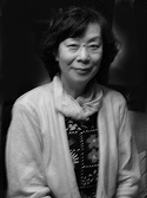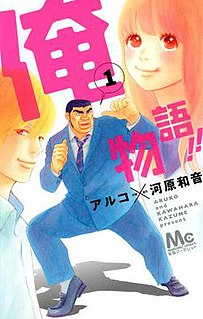
The Tale of Genji is a Japanese manga version of Murasaki Shikibu's The Tale of Genji by Waki Yamato.

Yokohama Kaidashi Kikō is a Japanese science fiction manga series written and illustrated by Hitoshi Ashinano. It was serialized in Kodansha's Monthly Afternoon magazine from June 1994 to February 2006, with a concluding postscript episode in July 2006, and collected in 14 tankōbon volumes. Parts of the story were adapted as two original video animation (OVA) anime series of two episodes each.

Moto Hagio is a Japanese manga artist who is considered a "founding mother" of modern shōjo manga, especially shōnen-ai. Hagio rose to prominence in the 1970s as a member of the influential Year 24 Group, and has been described as "the most beloved shōjo manga artist of all time." Hagio's notable works include The Poe Clan (1972–1976), The Heart of Thomas (1974), They Were Eleven (1975), and A Cruel God Reigns (1993–2001).

Nippon Animation is a Japanese animation studio. The company is headquartered in Tokyo, with chief offices in the Ginza district of Chūō and production facilities in Tama City.

Haikara-San: Here Comes Miss Modern, also known as Smart-san or Mademoiselle Anne, is a Japanese shōjo manga series by Waki Yamato. It was serialized by Kodansha in the magazine Shōjo Friend from 1975 to 1977. The title can be literally translated into English as Here Comes Miss Modern, Here Comes Miss High-Collar, or Fashionable Girl Passing By. In 1977, it was awarded the 1st Kodansha Manga Award for shojo.
Ema Tōyama is a female Japanese manga artist and illustrator. She made her debut in September 2003 in the monthly manga magazine Nakayoshi with her story, Tenshi no Tamago. Tokyopop licensed her first serialized manga Gokkun! Pūcho under the title Pixie Pop. Almost all of her works are published by Kodansha.

Psychometrer Eiji is a Japanese manga series written by Yuma Ando and illustrated by Masashi Asaki. It was serialized by Kodansha in Weekly Shōnen Magazine from 1996 to 2000, with its chapters collected in 25 tankōbon volumes. A sequel, titled Psychometrer, was serialized in Weekly Young Magazine from 2011 to 2014.
Fumi Yoshinaga is a Japanese manga artist known for her shōjo and shōnen-ai works.

Shōjo Friend was a shōjo manga magazine formerly published by Kodansha, beginning in 1962. Kodansha used the knowledge gained from publishing magazines aimed at young girls, including Nakayoshi and Shōjo Club, as well as the experience from publishing Weekly Shonen Magazine. Shōjo Friend is considered the successor to Shōjo Club. In 1963, Shueisha began publishing Margaret, and the two magazines became fierce competitors. Shogakukan entered the market competition in 1968 with Shōjo Comic.
Kyoko Mizuki is one of the pen names of Keiko Nagita. She is a Japanese writer who is best known for being the author of the manga and anime series Candy Candy.
Norifusa Mita is a Japanese manga artist born in 1958 from Iwate Prefecture. He is best known for Dragon Zakura for which he received the 29th Kodansha Manga Award. Dragon Zakura has been adapted to live-action television series in Japan and South Korea, its spin-off series Angel Bank received live-action television adaptation as well. His manga Investor Z was adapt into live-action television series in 2018 and The Great War of Archimedes was adapted into a film in 2019.
Aya Kanno is a Japanese manga artist. After working as an assistant to Masashi Asaki of Psychometrer Eiji fame, she debuted as a professional manga artist in Hana to Yume in 2001 with her fantasy-action series Soul Rescue. She has since published manga primarily in Hakusensha's shōjo (girls') manga anthologies: Hana to Yume, The Hana to Yume, Hana to Yume Plus, and Bessatsu Hana to Yume. Kanno is best known for her romantic comedy series Otomen, which was adapted into a live-action television drama in 2009. Her historical dark fantasy series Requiem of the Rose King, based on William Shakespeare's Richard III, will be adapted into an anime by J.C.Staff in 2022.
Yuna Kagesaki is a manga artist, born on March 3, 1973, best known for being the author of the manga Chibi Vampire. Her work has been published under four different names: Yuna Kagesaki, Yuna Kagezaki, Yūna Kagesaki when drawing CG's for PC games, and Yuta Kageyama when drawing hentai manga or HCG's for PC games.
In the bonus comic strips at the end of volume 3 of her work Hekikai no AiON, she refers to herself as "K-ya ", suggesting that her real name begins with "K" and ends with "ya". In middle school she was a member of the brass band.

Wata no Kunihoshi is a Japanese shōjo manga by Yumiko Ōshima. It was serialized by Hakusensha in LaLa magazine from 1978 to 1987 and collected in seven tankōbon volumes. The story is about an abandoned kitten called Chibi-neko who is adopted by a young man named Tokio who grows up believing that she is human. Wata no Kunihoshi received the 1978 Kodansha Manga Award for shōjo manga. It is credited with popularizing the kemonomimi (catgirl) character type.
Genji Monogatari Sennenki: Genji is a Japanese anime adaptation of The Tale of Genji. Originally, it was meant to be an anime adaptation of Waki Yamato's The Tale of Genji manga, but the director decided to make it a direct adaptation of the original tale. The anime is directed by Osamu Dezaki. The series premiered on Fuji TV on January 15, 2009.
Seimu Yoshizaki is a Japanese manga artist. She made her debut with Aka–chan to Tenshi in 1989. She is best known for Kingyo Used Books (2004–2020), serialized in Shogakukan's Monthly Ikki magazine.
Kazuyoshi Yokota was a Japanese anime director. His death was announced by screenwriter Nobuyuki Isshiki via Twitter. Isshiki had previously worked with Yokota on Uchūsen Sagittarius.

My Love Story!!, is a Japanese romantic comedy manga series written by Kazune Kawahara and illustrated by Aruko. The manga was serialized in Shueisha's Bessatsu Margaret magazine and is being published in English by Viz Media. An anime television adaptation by Madhouse began airing in April 2015 and a live action film adaptation of the same name was released on October 31, 2015.

Shōwa Tennō Monogatari is a Japanese manga series written by Issei Eifuku and illustrated by Junichi Nōjō, based on the novel Shōwashi by Kazutoshi Handō. It has been serialized in Shogakukan's seinen manga magazine Big Comic Original since April 2017.
Yamato is a Japanese surname.









